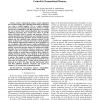412 search results - page 7 / 83 » Operating Systems Should Provide Transactions |
PPOPP
2009
ACM
14 years 1 months ago
2009
ACM
Abstract. Transactional memory (TM) promises to simplify construction of parallel applications by allowing programmers to reason about interactions between concurrently executing c...
SIGOPSE
1996
ACM
13 years 11 months ago
1996
ACM
Applications of the future will need to support large numbers of clients and will require scalable storage systems that allow state to be shared reliably. Recent research in distr...
MICRO
2010
IEEE
13 years 1 months ago
2010
IEEE
Today's transactional memory systems implement the two-phase-locking (2PL) algorithm which aborts transactions every time a conflict happens. 2PL is a simple algorithm that pr...
SRDS
2003
IEEE
13 years 12 months ago
2003
IEEE
We propose service continuations (SC), an OS mechanism that supports seamless dynamic migration of Internet service sessions between cooperating multi-process servers. Service con...
CIDR
2011
12 years 10 months ago
2011
Data state in a data management system such as a database is the result of the transactions performed on that data management system. Approaches such as single-message transaction...


